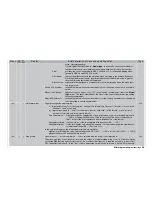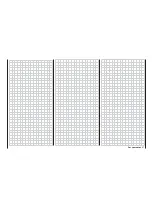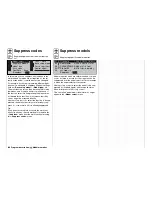
65
Note:
If you operate virtually all your models using the same
stick mode, and perhaps also with the same modu-
lation, it makes sense to select these preset values
in the global »
General basic settings
« menu (page
154). These two presets are automatically adopted
when you open a free model memory, but you can still
change them to suit a particular model if you wish.
Volume
When you select this line and give a brief press on
the rotary control, you can adjust the volume of the
audible signal of the ALARM TIMER(S) (»
Timers
(general)
« menu and »
Flight phase timers
« menu)
within the range 1 (very quiet) to 16 (very loud); this
adjustment is available separately for each model.
CLEAR
resets the volume to the default value of “6”.
Auto timer reset
Selecting “yes / no” in this line determines whether all
timers are automatically reset when you switch the
transmitter on. This does not apply to the “Model time”
and “Transmitter operating time” timers.
Power-on warning
If you assign a switch, a control switch or one of the
logical switches (see »
Logical switches
« menu,
page 97) in this line, the software will interrogate the
corresponding switch or control position when you
turn the transmitter on, and a warning message will
be superimposed on the basic display if necessary.
In combination with the logical switches virtually any
switch setting can be called up in this way when you
switch the transmitter on.
Program description:
Basic settings
Model name
#01
0:30h SPCM20
H-J.Sandbrunner
10.2V
0:30h C62
0
0
0
0
Stop
Flight
0 00
0 00
:
:
!Warning!
A triple warning beep sounds when the message is
displayed.
Typical applications:
• Electric motor on / off?
• Undercarriage retracted / extended?
• Correct fl ight phase activated?
• …
Auto Trimm
The “Auto-trim” option provides a fast, straightforward
method of trimming a model, e. g. as part of an initi-
al test-fl ight, or after (major) repairs or similar modifi -
cations.
Usually the sticks are used on their own during this
type of test-fl ight, until the desired stable fl ight condi-
tion is achieved. The pilot then attempts more or less
simultaneously to operate the trim levers to “reduce
the load” on the sticks.
This is precisely the situation where the “Auto-trim”
option comes into play: once you have used the pri-
mary stick functions 2 … 4 (aileron, elevator and rud-
der) to bring the model to a stable fl ight attitude, you
simply operate the switch assigned to the “Auto-
trim” function – ideally the momentary switch SW8 –
ONCE. The moment the switch is operated, the soft-
ware detects the deviations of the sticks from neutral,
and adopts them as the new trim values. However,
this does not occur instantly, but with a transition pe-
riod of about one second. During this period the pilot
should return the sticks to the normal (neutral) positi-
on, to avoid an abrupt change in the model’s attitude.
Notes:
• The Auto-trim function for ailerons is disabled if
you select “2 AIL 2 FL” or “2 AIL 4 FL” in the “Aile-
rons / fl aps” line of the »
Model type
« menu; this is
designed to avoid complex inter-actions which can
otherwise occur with multi-fl ap models.
• Please ensure that the aileron, elevator and rud-
der sticks are at their proper neutral position when
you assign the switch, otherwise any deviations
from the neutral position will be adopted as the
current trim values in the trim memory.
•
Since the effect of the Auto-trim function is cu-
mulative EVERY TIME you operate the assigned
switch, it is important for safety reasons to disable
the selected Auto-trim switch again after the con-
clusion of an “Auto-trim” fl ight, otherwise there is a
risk that you may operate the “Auto-trim” function
accidentally, and thereby inadvertently store the
wrong settings.
Summary of Contents for mx-24s
Page 1: ...1...
Page 19: ...19 For your notes...
Page 35: ...35 For your notes...
Page 41: ...41 41 For your notes...
Page 57: ...57 For your notes...
Page 63: ...63 63 For your notes...
Page 69: ...69 69 For your notes...
Page 85: ...85 85 For your notes...
Page 99: ...99 For your notes...
Page 143: ...143 For your notes...
Page 191: ...191 For your notes...
Page 212: ...212 212 For your notes...
Page 213: ...213 213 For your notes...
Page 214: ...214 For your notes...
Page 216: ...216...
















































